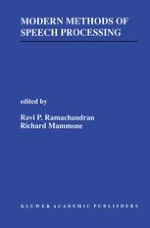
1995 | OriginalPaper | Buchkapitel
The Use of Pitch Prediction in Speech Coding
verfasst von : Ravi P. Ramachandran
Erschienen in: Modern Methods of Speech Processing
Verlag: Springer US
Enthalten in: Professional Book Archive
Aktivieren Sie unsere intelligente Suche, um passende Fachinhalte oder Patente zu finden.
Wählen Sie Textabschnitte aus um mit Künstlicher Intelligenz passenden Patente zu finden. powered by
Markieren Sie Textabschnitte, um KI-gestützt weitere passende Inhalte zu finden. powered by
Two major types of correlations are present in a speech signal. These are known as near-sample redundancies and distant-sample redundancies. Near-sample redundancies are those which are present among speech samples that are close together. Distant-sample redundancies are due to the inherent periodicity of voiced speech. Predictive speech coders make use of these correlations in the speech signal to enhance coding efficiency. In predictive speech coders, the cascade of two nonrecursive prediction error filters process the original speech signal. The formant filter removes near-sample redundancies. The pitch filter acts on distant-sample waveform similarities. The result is a residual signal with little sample to sample correlations. The parameters that are quantized and coded for transmission include the filter coefficients and the residual signal. From the coded parameters, the receiver decodes the speech by passing the quantized residual through a pitch synthesis filter and a formant synthesis filter. The filtering steps at the receiver can be viewed in the frequency domain as first inserting the fine pitch structure and then, shaping the spectral envelope to insert the formant structure. The formant and pitch filters are adaptive in that the analysis to determine the coefficients is carried out frame by frame. Also, the bits representing the quantized parameters are transmitted on a frame by frame basis. The bit rate of the coder is the total number of bits transmitted in one frame divided by the time duration of the analysis frame.